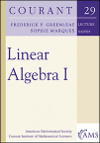- About MAA
- Membership
- MAA Publications
- Periodicals
- Blogs
- MAA Book Series
- MAA Press (an imprint of the AMS)
- MAA Notes
- MAA Reviews
- Mathematical Communication
- Information for Libraries
- Author Resources
- Advertise with MAA
- Meetings
- Competitions
- Programs
- Communities
- MAA Sections
- SIGMAA
- MAA Connect
- Students
- MAA Awards
- Awards Booklets
- Writing Awards
- Teaching Awards
- Service Awards
- Research Awards
- Lecture Awards
- Putnam Competition Individual and Team Winners
- D. E. Shaw Group AMC 8 Awards & Certificates
- Maryam Mirzakhani AMC 10 A Awards & Certificates
- Two Sigma AMC 10 B Awards & Certificates
- Jane Street AMC 12 A Awards & Certificates
- Akamai AMC 12 B Awards & Certificates
- High School Teachers
- News
You are here
Linear Algebra I

Buy Now:
Publisher:
AMS
Publication Date:
2019
Number of Pages:
261
Format:
Paperback
Edition:
1
Series:
Courant Lecture Notes
Price:
51.00
ISBN:
978-1-4704-4871-4
Category:
Textbook
[Reviewed by , on ]
Fernando Gouvea
03/29/2019
This Linear Algebra textbook is aimed at two audiences. The first is majors in mathematics who need a more advanced linear algebra course with full proofs. The second is graduate students in need of a deeper and more complete introduction to linear algebra. The book derives from the notes for a course taught at the Master’s program in Mathematics. The audience for this course includes students whose undergraduate degrees were in other disciplines and mathematically talented students who are returning to school after working for a few years.
It is easy to see why such a course is necessary: most undergraduate mathematics programs require a basic course in linear algebra, but few require students to return to the subject when they are more mature and ready for a more rigorous version. We seem to expect students to either “pick up” the material somehow, perhaps from courses in abstract algebra and/or functional analysis. In fact, most of our students would benefit immensely from a course based on a textbook like this one.
The first two chapters of the book cover material from an introductory linear algebra course: vector spaces, linear operators and matrices, eigenvalues, dimension. Of course, everything is done rigorously and over a general field. The only topics that might not appear in the elementary version of the course are quotient spaces and direct sums.
Then things get harder. The third chapter looks at dual spaces and introduces the transpose operator, while the fourth gives a proper treatment of determinants by way of the permutation group \(S_n\). The last two chapters deal with diagonalization and inner product spaces; the level here is distinctly more advanced. Along the way we meet the various norms on spaces of matrices (and their equivalence), learn to use diagonalization to compute the exponential of a matrix, and study the properties of self-adjoint, normal, and unitary operators. Starting from about the middle of chapter 5, the underlying field is usually assumed to be either \(\mathbb R\) or (more often) \(\mathbb C\).
The goal of this first volume seems to be to get to inner product spaces and the various structure theorems for operators on such spaces. Thus, there is no discussion of Jordan canonical form or Smith normal form (which I presume will appear in volume II), but there is a treatment of singular value decompositions as a corollary of the polar decomposition \(T=UP\), where \(U\) is unitary and \(P\) is positive.
There are a few typos, most of which seem to be \(\LaTeX\) tagging mistakes. For example, in a few places one sees what seem to be remnants of \index tags. One strange decision is to postpone the proof of Theorem 1.70 (the columns of \(A\) in which the RREF form of \(A\) has pivots form a basis of the column space). The authors say the proof relies on determinants, but in fact it follows easily from the fact that row operations preserve linear relations between columns.
A course based on this book would make a very nice capstone course for students interested in applied mathematics, particularly if some links to applications were provided. I am sure it serves Courant’s master students well.
Fernando Q. Gouvêa is Carter Professor of Mathematics at Colby College in Waterville, ME.
See the publisher's table of contents.
- Log in to post comments




